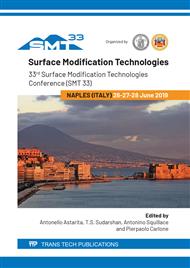p.352
p.358
p.364
p.370
p.376
p.381
p.387
p.393
p.399
Influence of the Metallic Cold Spray Deposition on the Low-Velocity Impact Behaviour of Composite Laminates
Abstract:
Recently, the growing attraction to the development of new eco-sustainable composite materials is driving the research interest toward the replacement of synthetic reinforcing fibres with natural ones and exploiting the inherent recyclability of thermoplastic resins even for uses in which thermosetting matrices are well consolidated (e.g. naval and aeronautical fields). Among the natural fibres, a growing interest of the research is addressed to basalt fibres. Focusing the attention on thermoplastic composites, many experimental findings already available in literature highlight the outstanding mechanical properties of composite materials including basalt fibres and their potentiality concerning glass ones. On the other hand, some issues are related to the surface properties of the bio-laminates: in particular, the wear ones, the flame resistance and the aesthetic appearance have to be improved to extend the application fields of these materials. Aiming to these goals, this paper deals with the study of the deposition ofaluminium coating through cold spray process on polypropylene/basalt fabric composite laminates. The specimens were obtained by film stacking, and compression moulding technology and their performances were studied in terms of low-velocity impact behaviour, considering the influence of the surface modification with the aluminium coating. The results obtained from the reference laminates and the coated ones are compared in terms of impact parameters: the aluminium deposition seems to affect the damage mechanism propagation even if the impact response seems to be similar in both conditions.
Info:
Periodical:
Pages:
376-380
Citation:
Online since:
July 2019
Keywords:
Price:
Сopyright:
© 2019 Trans Tech Publications Ltd. All Rights Reserved
Share:
Citation:


